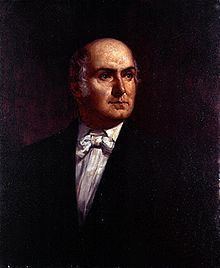Name Abel Upshur | Preceded by George E. Badger | |
 | ||
Born June 17, 1790Northampton County, Virginia, U.S. ( 1790-06-17 ) Spouse(s) Elizabeth Dennis Upshur (died 1817)Elizabeth Ann Brown Upshur Books A Brief Enquiry Into the Tr, Our Federal Governm, A Brief Inquiry Into the True, The Federal Governm | ||
Founding perspective john tyler and abel p upshur
Abel Parker Upshur (June 17, 1790 – February 28, 1844) was an American lawyer, judge and politician from Virginia. Upshur was active in Virginia state politics and later served as Secretary of the Navy and Secretary of State during the administration of President John Tyler. Upshur was instrumental in negotiating the secret treaty that led to the 1845 annexation of Texas to the United States and played a key role in ensuring that Texas was admitted to the United States as a slave state. He was among six people killed on February 28, 1844, when a gun exploded during a Potomac River pleasure cruise on the USS Princeton.
Contents
- Founding perspective john tyler and abel p upshur
- Donald livingston on abel p upshur and joseph story
- Early life and career
- Marriage and family
- Political career
- Secretary of the Navy
- Secretary of State
- USS Princeton explosion
- Legacy
- References
Donald livingston on abel p upshur and joseph story
Early life and career
Upshur was born in Northampton County, Virginia, in 1790, one of 12 children. His father Littleton Upshur—described as a "staunch individualist and rabid Federalist"—owned the plantation Vaucluse, and was a member of the Virginia Legislature and a captain in the U.S. Army during the War of 1812.
Upshur attended Princeton University and Yale College; he was expelled from the former for participating in a student rebellion. He did not graduate, returning to Richmond, Virginia, to study law with a private firm. Upshur was admitted to the bar in 1810; he briefly set up practice in Baltimore, Maryland, but returned to Virginia after the death of his father. He developed a thriving law practice and became active in state politics.
Marriage and family
Upshur married Elizabeth Dennis on February 26, 1817; she died in childbirth on November 28, 1817. He later remarried to his second cousin, Elizabeth Ann Brown (née Upshur); they had one daughter, Susan Parker Brown Upshur (1826–1858).
Political career
Upshur was elected to a term in the Virginia House of Delegates in 1812, was Commonwealth's Attorney for Richmond (1816–1823), ran unsuccessfully for the U.S. Congress, and returned to the state legislature from 1825 to 1827. He was elected to the Virginia General Court in 1826, and was an influential delegate to the Virginia State Constitutional Convention of 1829–1830.
Throughout his political career, Upshur was a stalwart conservative and advocate for states' rights. He opposed democratic reform at the Virginia Convention of 1829–30, and during the nullification movement in South Carolina, he defended the principle of nullification and the state in a series of letters entitled "An Exposition of the Virginia Resolutions of 1798". Upshur's view of the Constitution received its fullest expression in his 1840 treatise in response to Judge Joseph Story, A Brief Enquiry into the Nature and Character of our Federal Government: Being a Review of Judge Story's Commentaries on the Constitution of the United States.
Secretary of the Navy
After John Tyler became President of the United States in 1841, he appointed Upshur as the 13th United States Secretary of the Navy in October of that year. His time with the Navy was marked by a strong emphasis on reform and reorganization, and efforts to expand and modernize the service. He served from October 11, 1841, to July 23, 1843. Among his achievements were the replacement of the old Board of Navy Commissioners with the bureau system, regularization of the officer corps, increased Navy appropriations, construction of new sailing and steam warships, and the establishment of the United States Naval Observatory and Hydrographic Office.
Secretary of State
In July 1843, President Tyler appointed Upshur United States Secretary of State to succeed Daniel Webster, who had resigned. His chief accomplishment was advocating for the annexation of the Republic of Texas as a slave state. Upshur and Texas ambassador Isaac Van Zandt worked closely on the treaty of annexation until Upshur's death. He was also deeply involved in the negotiations in the Oregon boundary dispute and was a strong advocate of bringing the Oregon Country into the union. He was eventually willing to settle on the 49th parallel compromise for the northern border between the United States and Canada, although negotiations were not finished until after his death and the end of Tyler's term as president.
USS Princeton explosion
On February 28, 1844, Upshur joined the President and other dignitaries for a Potomac River cruise on the new steamship USS Princeton. He and five others were killed when one of the ship's guns exploded during a demonstration of its firing power. He was buried at the Congressional Cemetery in Washington, D.C. Thirty years later his remains were re-interred at Oak Hill Cemetery, also in Washington, D.C.
Legacy
These places have been named for him:
